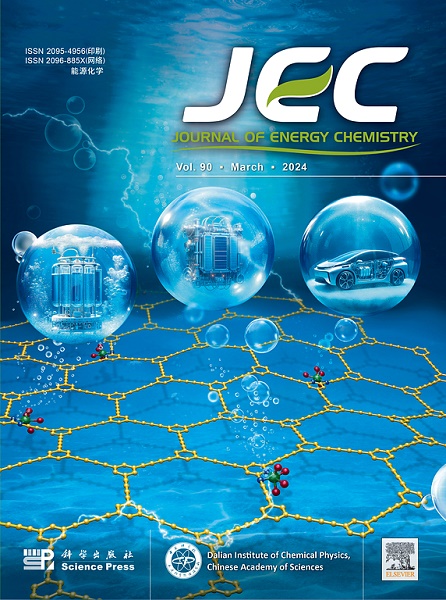Ruthenium catalyst supported on perovskite-type alkaline earth metal-titanates with strong metal-support interaction for ammonia decomposition
IF 13.1
1区 化学
Q1 Energy
引用次数: 0
Abstract
Alkaline earth-metal titanates ATiO3 (A = Ca, Sr, and Ba) with a perovskite-type structure were used as supports for Ru-based catalysts to produce COx-free H2 via NH3 decomposition. The effects of alkaline-earth metals on the physicochemical characteristics and catalytic activities of Ru/ATiO3 for NH3 decomposition were investigated using various techniques. The order of Ru/ATiO3 for NH3 conversion is Ru/BaTiO3 > Ru/SrTiO3 > Ru/CaTiO3 > Ru/TiO2 at the identical conditions, with the Ru/BaTiO3 catalyst demonstrating the highest NH3 conversion of 77.8% at 450 °C and a gas hourly space velocity of 30,000 mL/gcat/h, which is 8.7, 2.1, and 1.3 times of that over Ru/TiO2, Ru/CaTiO3, and Ru/SrTiO3, respectively. The formation of the ATiO3 phase can enrich the concentration of basic sites and oxygen vacancies compared with TiO2, which can induce the presence of strong metal-support interaction (SMSI) through the formation of Ru–O–Ti bonds. This SMSI effect increased the dispersion and electron density of Ru nano-particles on ATiO3 supports, and the electron-rich Ru nano-particles could weaken the chemisorptive strength of N2 and H2 on the Ru/ATiO3 catalysts, thereby promoting the reaction rate for NH3 decomposition.

求助全文
约1分钟内获得全文
求助全文
来源期刊

Journal of Energy Chemistry
CHEMISTRY, APPLIED-CHEMISTRY, PHYSICAL
CiteScore
19.10
自引率
8.40%
发文量
3631
审稿时长
15 days
期刊介绍:
The Journal of Energy Chemistry, the official publication of Science Press and the Dalian Institute of Chemical Physics, Chinese Academy of Sciences, serves as a platform for reporting creative research and innovative applications in energy chemistry. It mainly reports on creative researches and innovative applications of chemical conversions of fossil energy, carbon dioxide, electrochemical energy and hydrogen energy, as well as the conversions of biomass and solar energy related with chemical issues to promote academic exchanges in the field of energy chemistry and to accelerate the exploration, research and development of energy science and technologies.
This journal focuses on original research papers covering various topics within energy chemistry worldwide, including:
Optimized utilization of fossil energy
Hydrogen energy
Conversion and storage of electrochemical energy
Capture, storage, and chemical conversion of carbon dioxide
Materials and nanotechnologies for energy conversion and storage
Chemistry in biomass conversion
Chemistry in the utilization of solar energy
 求助内容:
求助内容: 应助结果提醒方式:
应助结果提醒方式:


